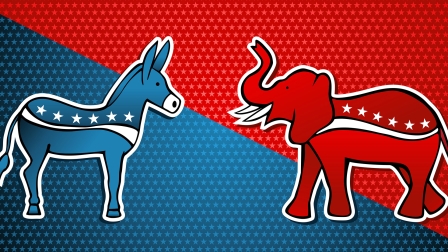Ads on Facebook, Instagram, Twitter and especially Snapchat can be pinpointed to people within polling places’ no-signs zones.

In California — and other states like Texas and New York — you’re not allowed to visibly promote a political candidate within 100 feet of a polling place on an election day. It violates the state’s law against electioneering. That means, this morning I couldn’t stand outside my local polling place and hold a sign advocating for Hillary Clinton or Donald Trump. But I could buy ads in social apps like Facebook, Instagram, Snapchat and Twitter aimed at people in the area.
Facebook, Instagram, Twitter and especially Snapchat offer location-based ad targeting options that can be used to pinpoint people within varying proximities of a polling place.
Whether ads on Facebook, Instagram, Snapchat and Twitter that are targeted to polling places would run afoul of electioneering law appears to be, at best, a gray area. The press secretary for the California Secretary of State has not returned a phone message left on Monday asking whether these ads would violate the law.
On Facebook and Instagram I can advertise to anyone within 1 mile of the polling place by buying Facebook’s Local Awareness Ads. On Twitter the narrowest I can get is running a Promoted Tweet campaign to anyone within the same zip code, though I can add audience-targeting filters like people believed to be Democratic and Republican voters and people Twitter has categorized as interested in Election Day.
These ads would be more precise than an ad that doesn’t use location targeting, making them more likely to reach people within a 100-foot radius of the polling place. But they wouldn’t only reach people within a 100-foot radius of the polling place. Instead of being the digital equivalent to someone standing just outside the polling place with a “Vote for Hillary” sign, they’re closer to that person holding a megaphone from a couple blocks away and shouting “Vote for Hillary” within earshot of the polling place or a large billboard that’s a mile away but within view of the polling place.
As a result, these ads would be “unlikely” to violate the California Elections Code, said Derek Muller, associate professor of law at Pepperdine University School of Law, in an email. The likelihood hinges on whether the state’s Attorney General would interpret the ad as violating the rule prohibiting electioneering and whether that interpretation upheld the First Amendment of the U.S. Constitution.
“I think there’s a difference between someone bringing an ad from outside the polling place into it (like a phone with an ad already on it), versus an ad triggered when someone steps into the polling place (much closer to the concern raised in the electioneering context). If that’s the case, I imagine the AG is more likely to view that as a violation of the statute and that enforcing it would not run afoul of the First Amendment,” said Muller.
On Snapchat it would be possible to trigger an ad when someone steps into the polling place. Anyone can buy from Snapchat an on-demand geofilter — an overlay that can be applied to a photo or video someone shares on Snapchat — that would be only shown to people within a defined physical area, like a polling place. See for yourself. Here’s an on-demand geofilter I created around my local polling place.

It’s unclear whether these social platforms can and do block ads from being shown within 100 feet of polling places in order to not risk violating the law. Given that Google is able to tell search users where their designated polling place is located, it seems like Facebook/Instagram, Snapchat and Twitter would be able to get their hands on polling place data.
Facebook requires advertisers comply with local laws, according to a Facebook spokesperson. Snapchat and Twitter declined to comment for this article.
Based on ads I ran on Facebook, Instagram and Twitter this morning — targeted the way I mentioned earlier — and seen live on my girlfriend’s phone while in line at the polling place, those companies do not have any blocks in place. I’ve submitted a Snapchat on-demand geofilter that’s fenced around my polling place like in the picture above, but it’s still under review.
Marketing Land – Internet Marketing News, Strategies & Tips
(62)
Report Post




